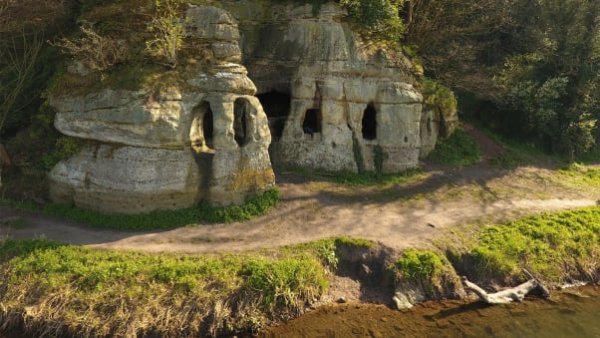Archaeologists in England have identified an almost completely preserved cave home from the Saxon period, in which they believe lived a king who became a saint, CNN reports.
The home in central English Derbyshire, believed to be from the early 9th century, was discovered by a team from the Royal Agricultural University (RAU) and Wessex Archeology in one of the Anchor Church caves, according to a media report on Wednesday. The team conducted a detailed study of the cave complex in Derbyshire, and came to the conclusion that they are from the early medieval period, and not from the XVIII century, as previously thought.
Edmund Simons, a research fellow at RAU, told CNN that the home of the deposed king was a “small, intimate space” that is one of the oldest home interiors preserved in Britain. Although there are several churches with intact interiors dating from the same period, “nowhere else can you see a place where someone really ate, slept, prayed and lived 1,200 years ago,” Simons said. The cave dwelling had three rooms and a chapel.
Dating of the cave house
A number of factors have been taken into account in determining the age of the 9th-century home, Simons said. The caves are carved into soft sandstone and their narrow doors and windows resemble Saxon architecture from the period, while the pillar carved into the rocks is similar to that found in the nearby Saxon crypt.
Local folklore and a fragment from a 16th-century book connect the Ankor Church caves with a saint. St. Hardulf was identified as King Eardulf, who ruled Northumbria (one of the island kingdoms between present-day England and Scotland) until 806. He died around 830 and was buried on a hill near the caves.
Hardulf is one of a series of deposed Saxon kings who lived out their years as monks or hermits. For them, it was a way to preserve their status, sometimes their lives. But he was not a “bearded freak living in complete solitude in a cave,” Simons said, but a kind of living saint who had servants, students, and visitors seeking his advice. “The hermits were important and holy people,” says Simons. It’s an incredibly religious period. “
At the time of his death, Viking attacks on the British Isles, which began in the late eighth century, became more frequent. They arrived in the area shortly after Hardulf’s death. Since their pagan army killed all the local religious figures, it must be assumed that the cave house was before their arrival, Simons explained. “That’s how everything fits,” he added.
Cave dwellings have often been unfairly ignored by historians, says Simons, but they are “the only surviving dwellings that have survived since the Saxon period.” So far, more than 20 other similar homes have been discovered in the West Midlands, he said, “some of which may be even older.”
“It’s amazing that home buildings from more than 1,200 years ago have been preserved in such a prominent place, unrecognized by historians, antiquaries and archaeologists,” said Mark Horton, a professor of archeology at RAU, in a press release.
“We are confident that other examples will be found to give a unique perspective to Anglo-Saxon England.”
The study is published in the Proceedings of the University of Bristol Spelaeological Society.












